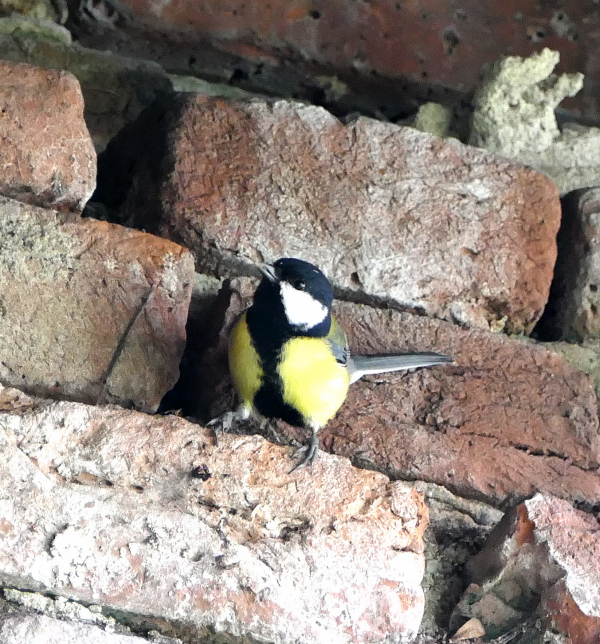Parus major, commonly known as the great tit, is a bird species belonging to the Paridae family. It is widely distributed across Eurasia, from Europe to the eastern parts of Asia, and in the northern regions of Africa. This species is characterized by its remarkable ability to adapt to various habitats, including deciduous forests, coniferous woodlands, gardens, and urban areas. The great tit is particularly appreciated for its striking appearance and dynamic behavior, making it easily observable throughout the year.
The adult plumage of Parus major features several distinct characteristics. The head is completely black, with a black stripe running across the chest and abdomen, while the upper body is olive green with greyish and yellowish hues on the underside. The upper parts of the wings and tail are darker, providing a stark contrast to the rest of the body. Females and juveniles tend to have less vivid coloring, but the black marking across the chest is always present.

Scientific Classification
Kingdom: Animalia
Phylum: Chordata
Class: Aves
Order: Passeriformes
Family: Paridae
Genus: Parus
Species: Parus major
Chemical Composition and Structure
The body structure of Parus major is designed to optimize flight, with a relatively compact body and plumage that favors aerodynamics. Its skeleton is lightweight yet robust, a feature that allows for easy flight and maintains balance during rapid movement between branches and shrubs. The skin beneath the feathers consists of elastic and durable tissues, which protect the bird from temperature fluctuations and moisture.
The feathers of Parus major, like those of other birds, are composed mainly of keratin. Their structure is such that each feather is made of a central shaft (rachis) with barbs arranged in a way that they interlock with each other, creating a waterproof surface that aids in thermoregulation and protection against weather conditions. Flight feathers, in particular, are long and stiff, while body feathers are softer and more flexible.
Physical Properties
Parus major has a body length ranging from 12 to 14 cm, with a wingspan reaching 22-24 cm. Its weight varies between 18 and 22 grams, a mass that allows it to fly swiftly and move rapidly between tree branches. Its flight ability is one of its primary characteristics, as it can perform quick flights and sharp directional changes due to its lightweight and powerful, short wings.
These physical traits are perfectly adapted to its environment: its agility makes it an effective predator of insects and small invertebrates, while its ability to quickly fly between branches helps it evade predators.
Reproductive Process and Biological Cycle
The reproductive period of Parus major primarily occurs in spring and summer. Males attract females with melodious songs and a series of courtship behaviors, including the offering of food. Once the female accepts the male, both participate in nest building, which is usually done in tree cavities, old birdhouses, or even in cracks in walls in urban settings.
The eggs, which can range from 6 to 12, are white with black or brown spots. Incubation lasts about 12-14 days, during which the female is mainly responsible for protecting the eggs, while the male provides food. Once hatched, the chicks are blind and featherless, and depend entirely on their parents for feeding, which consists primarily of insects and seeds.
The chicks become independent after about 3 weeks, but often remain close to the nest for a while before they are ready to fly. The diet of the adults is largely based on seeds and insects, with a diet that varies according to the season and food availability.
Ecology and Environmental Role
Parus major plays a crucial role in the ecosystem as a predator of insects, particularly species that can damage crops. Its role in controlling insect populations is especially important in agricultural areas, where it acts as a natural predator, reducing the need for chemical pesticides. Additionally, Parus major is an important indicator species of habitat quality. Its presence and the health of its population can reflect the quality of the surrounding environment, particularly in terms of biodiversity and pollution levels.
Its feeding habits are closely linked to the seasons: during the winter, when insect availability decreases, it primarily feeds on seeds and berries but will also consume small vertebrates, such as the chicks of other species. This bird has significant adaptability to climate changes, managing to survive in urban environments where it can feed on seeds provided by humans.
Environmental and Conservation Considerations
While Parus major is not currently threatened, its population may be affected by habitat loss, climate change, and pollution. Destruction of forests, reduction of natural cavities for nesting, and air and water pollution are all factors that could impact its ability to survive in some areas. In some regions, the presence of Parus major is also threatened by competition from invasive species, such as pigeons or blackbirds.
Parus major benefits from the protection of natural habitats and the conservation of mature forests. Conservation policies should focus on protecting natural environments and adopting sustainable forest management practices to ensure that this species can continue to thrive in the future.



